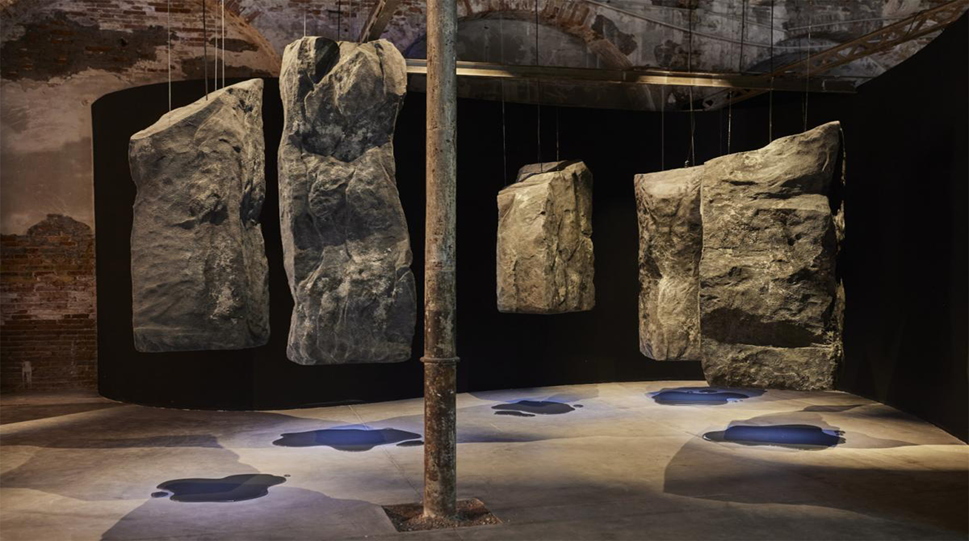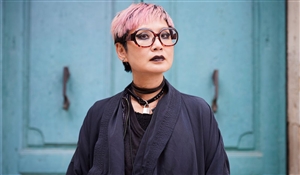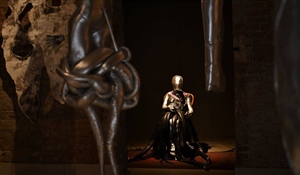Oman's Contemporary Art at the Venice Biennale 2022
11 Sep 2022Original text in Farsi by Nafiseh Saleh Abadi
Translated to English by Omid Armat
"Destined Imaginaries," as selected by Aisha Stoby, is the title of a show in which works by Omani artists are displayed at the Venice Biennale 2022. Stoby, an art historian and the Omani pavilion's curator at the 59th edition of the biennale, has selected artworks by three generations of Omani contemporary artists to be presented. Anwar Sonya, Hassan Meer, Budoor Al Riyami, Radhika Khimji, and Raiya Al Rawahi are the artists whose works are exhibited with regard to the question "What would life look like without us?" propounded by Cecilia Alemani, the supervisor of this edition of the Venice Biennale.

Anwar Sonya and Raiya Al Rawahi | Speed of Art | 2017 – 2022 | Installation view | Commissioned by The Sultanate of Oman Pavilion | Source: www.wallpaper.com
The artworks displayed by Omani artists in their first presentation at this event are centered on concepts of the past, the future, the environment, and identity. The two-year hiatus in the regular execution of the biennale due to the Coronavirus pandemic caused many artists' approaches to change toward works concerned with fundamental subjects of death, life, and questions about them. Omani artists have followed the same path while considering the importance of their country's first presence at this event.
"Breathe" is the title of Budoor Al Riyami's installation consisting of five sculptures, similar to rough rocks hanging with thin strings from the pavilion's ceiling; on the gallery's floor, right beneath the sculptures, a resin-like liquid is poured in which the reflection of a video screen near the ceiling is visible. In another part of the pavilion, a black, convex curtain is installed, similar to an abstract fuselage on which a joint video titled "Speed of Art," created between 2017 and 2022 by Anwar Sonya and Raiya Al Rawahi is played. The video screen is like an airplane window, and its content refers to the relationship between art and technology. "Robots are controlling us," a sentence stated in this video art, may not be a promising thing to hear, but it makes the viewer engage with a world that they will soon fully understand all its aspects.

Hassan Meer | Reflections From Memories | 2009 – 2022 | Installation view | Source: www.wallpaper.com
In an installation called "Reflections from Memories," Hassan Meer collected objects dating back to 2009 from his grandfather's house in Muscat. Antique suitcases, wooden chests of different sizes, letters, and personal notebooks are arranged on a niche-like platform with monitors installed between them showing photographs of Oman's urban space. On the two larger monitors in the background, ten-minute videos are screened, which are, according to Meer, inspired by "the soul of my grandfather's old house." It seems that the artist had engaged with nostalgic feelings about the objects. An old sewing machine, a watch that will never work again, and a dusty rug are all placed in the modern space of the gallery as if they are unfamiliar objects that have traveled in time and ended up, at this moment, in a pavilion in a remote country.
The last installation, titled "Under, Inner, Under," was created by Radhika Khimji, the fifth artist introduced to the Venice Biennale. The installation that seems to occupy the most space in the pavilion includes seven fabrics with detailed paintings, a wooden sculpture, two wooden paintings, and structures attached to each other like tiles. Aisha Stoby explains: "Each presented work here is inspired by Oman's landscapes in a way that each of them is supposed to embody a part of the country's geography in Arsenale. What we see by Khimji in this presentation is in relation to those landscapes."

Radhika Khimji | Under, Inner, Under, 2022 | Installation view | Commissioned by The Sultanate of Oman Pavilion | Source: www.wallpaper.com
Al Hoota has presented a series of caves in Oman with two million years of age. The caves are home to a species of fish that has lost vision during retrogressive adaptation to the lack of light in these caves, thus being known as the blind fish. In Khimji's installations, her imagination about the blind fish is embodied as it has left its habitat, experiencing living in a space outside the cave. Stoby explains: "It's about how we respond to our environments, and whether our environments define us."
Besides a few works focused on history, landscape, and nostalgia, the Omani pavilion is more of a modern place instead of concentrating on reviewing periods of Oman's art history. Working in the curatorial field as a young figure with an academic viewpoint on art, Stoby, in cooperation with the five artists, created a space that is concerned with art scenes on a global scale and competes with them. Representing three generations of Oman's artists is more of an attempt to discover time and its relationships rather than a histography of art. "The Circle", an influential art movement whose activity began in the early 1990s, added a new approach to Oman's art; the movement, founded by Hassan Meer, has deeply influenced artists working in different fields like photography, video, and installation.
Sources:
-
www.thenationalnews.com/arts-culture/2022/05/20/inside-omans-first-venice-biennale-pavilion-where-time-is-out-of-joint
-
www.labiennale.org/en/art/2022/oman-sultanate
-
www.wallpaper.com/art/oman-pavilion-59th-venice-biennale-2022
-
www.omanpavilion.org
-
www.artnews.com/art-news/news/oman-first-national-pavilion-venice-biennale-1234611861
-
www.veniceartfactory.org/pagina-mostre/destined-imaginaries-%2F%2F-sultanate-of-oman-pavilion
-
www.agsiw.org/oman-debuts-at-the-59th-venice-biennale-with-destined-imaginaries
Cover and slider image:
- www.wallpaper.com






